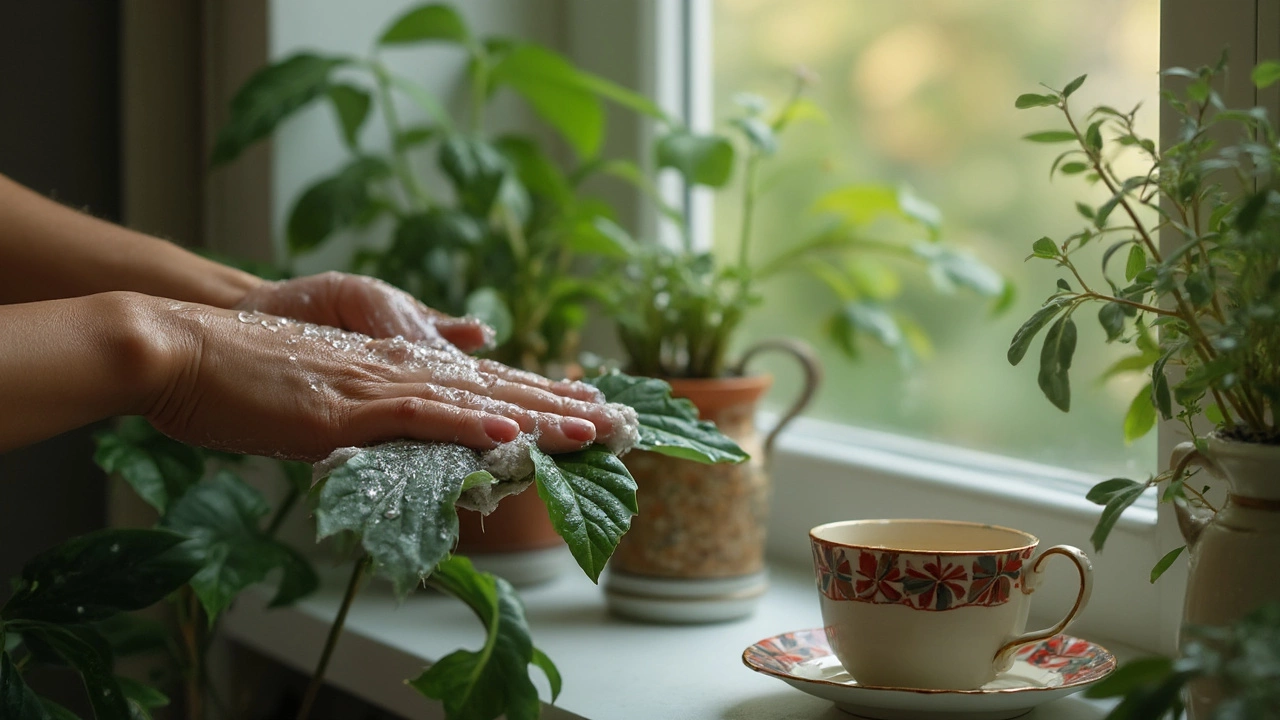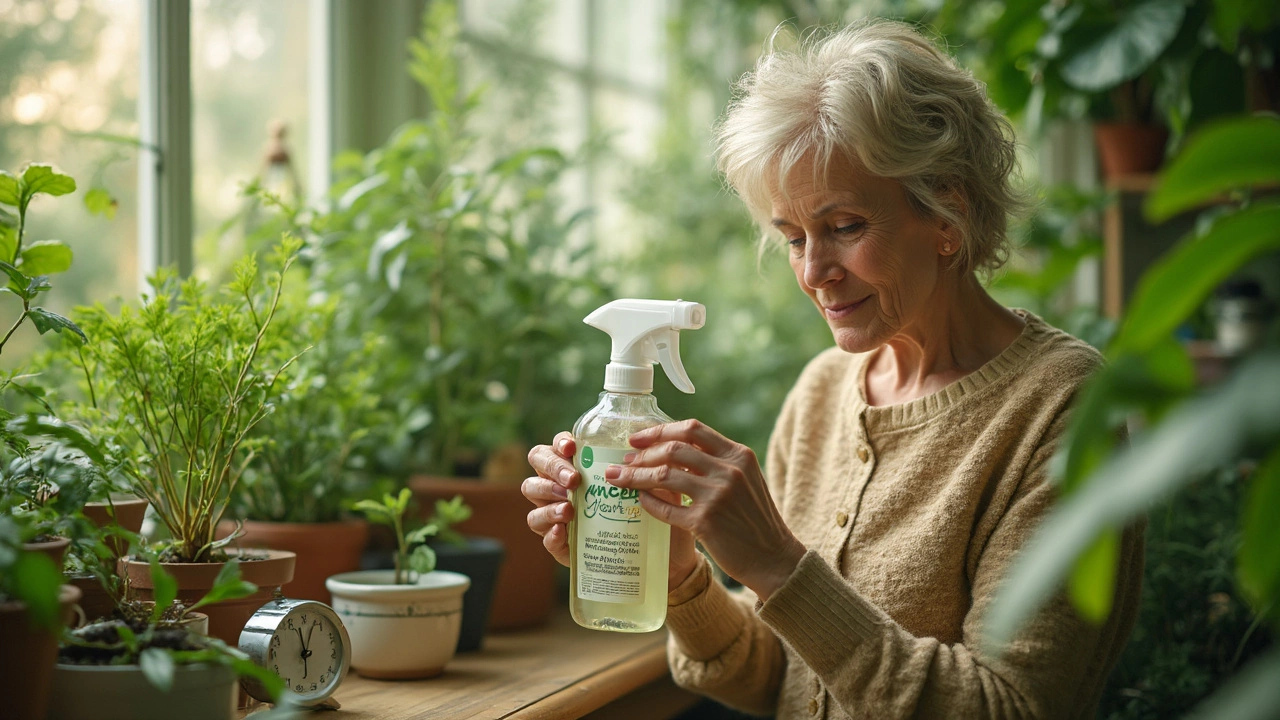Soapy water is a go-to hack for battling bugs on your indoor plants. But here's where most folks trip up—they're not sure how long to keep that sudsy stuff on. Leave it too short, and the pests laugh it off. Too long, and your plant might get stressed or show weird spots.
The trick isn't complicated, but it’s easy to overlook. The general rule? Ten to fifteen minutes is plenty for most houseplants. After that, you’ll want to rinse the leaves with plain water, making sure you wash off all the soap residue. This short window is enough to mess up the bugs’ soft bodies, but not so long that your plant absorbs harsh chemicals from the soap.
Before you reach for the dish soap, remember: Not all soaps are created equal. Go for a plain liquid soap with no added fragrances or harsh degreasers—think gentle, like what you'd use in a baby bath. The old-school green soap bars or castile soap are winners here. Just a couple drops per quart of water is enough.
Seen a sticky residue or yellowing leaves after trying the soap trick? That's usually a sign you left it on too long, or maybe your soap was too strong. These things can sneak up on you and mess with your plant’s photosynthesis. Thankfully, with a timer and a gentle rinse, it's easy to avoid.
- Why Use Soapy Water on Plants?
- How Long Should You Leave It On?
- Risks and What Can Go Wrong
- Tips for Safe and Effective Use
Why Use Soapy Water on Plants?
When it comes to indoor plants, bugs like aphids, spider mites, and mealybugs are annoying and pretty common. Most people don’t want to use harsh chemicals on their houseplants, especially if pets or little kids are around. That’s where soapy water steps in—it’s a simple, cheap fix that’s been used in real-life plant care for ages.
Soapy water works because it messes with bugs’ protective layers and their ability to breathe. The soap breaks down the waxy coat that protects them, and they quickly dry out or suffocate. Here’s the cool part: when you use a gentle soap, most plants shrug it off just fine, but the bugs don’t stand a chance.
Here’s a quick breakdown of how soapy water helps your indoor plants:
- Kills soft-bodied pests fast: It’s tough on aphids, thrips, whiteflies, and spider mites without harming beneficial bugs indoors (not that you get ladybugs in your living room anyway).
- Safe and non-toxic: As long as you pick the right soap, you’re skipping dangerous pesticides. That’s great for people and pets.
- Budget-friendly: Compared to specialty sprays, soap is dirt cheap and easy to find.
- No special gear required: Just mix and spray—no mask or gloves needed if you’re using gentle soap.
Here's a quick look at what soapy water can do versus store brand pest sprays:
| Method | Targets | Safe for Plants | Cost |
|---|---|---|---|
| Soapy Water | Aphids, spider mites, mealybugs | Yes (if used right) | Low |
| Chemical Sprays | Wide range | Sometimes harsh | High |
So, if you see tiny bugs crawling around your greenery, don’t panic. A quick soapy water spray is usually enough to knock things back into balance—just be sure you use it correctly to avoid issues.
How Long Should You Leave It On?
This is the big question when you’re using soapy water as a DIY indoor plant care fix. After you’ve sprayed your plant all over with the soapy mix, you really only need 10 to 15 minutes for it to do the job. If you leave it much longer, you start risking more harm than good.
What’s really happening in those few minutes? The soap actually breaks down the outer coating of soft-bodied pests like aphids, spider mites, and mealybugs. Once their defenses are down, they can’t survive. Studies from gardening extension programs show that most bugs start to die within five to ten minutes of contact with diluted soap, so there’s no point letting it sit all afternoon.
Here's how to get it right:
- Mix 1-2 teaspoons of mild liquid soap per quart of water (no fancy stuff needed).
- Spray all the plant surfaces where you spot bugs, making sure to get under the leaves too.
- Set a timer for somewhere between 10-15 minutes—don’t just guess.
- After time’s up, rinse every soapy part with clean, room-temp water.
Check out these numbers for some reference:
| Soap Exposure Time | Plant Health Risk | Pest Control Effectiveness |
|---|---|---|
| 5 minutes | Low | Good |
| 10-15 minutes | Low | Best |
| 30+ minutes | Moderate-High | No extra benefit |
Letting soapy water linger too long or skipping the rinse can mess up your indoor plants. Your goal is a quick in-and-out job—hit the bugs, spare the plant. That’s how you get the most out of this natural pest control trick, without learning the hard way what soap scald looks like on your leaves.

Risks and What Can Go Wrong
Using soapy water on indoor plants sounds super simple, but there are some gotchas you have to watch for. The biggest risk is damaging your plant’s leaves. If you use a soap that's too strong or leave it on for more than fifteen minutes, your plant can end up with brown, dried-out patches or even burned spots. These show up because the soap strips away the protective wax from leaf surfaces, making them weak and exposed.
Another common issue is soap residue. Miss a spot during rinsing, and you’ll see sticky, filmy leaves after a while. Over time, this messes up your plant's ability to "breathe" and do photosynthesis. Some houseplants are especially sensitive—ferns, African violets, and succulents can react badly, even to gentle soap mixes.
Using the wrong kind of soap is a recipe for trouble, too. Dish soaps packed with degreasers, antibacterial stuff, or scents may seem harmless, but they have additives that can harm plant cells. Stick to pure castile soap or a liquid soap with as few extras as possible.
If you’re blasting your plant with soapy water over and over, watch out for root problems. Excess drips can collect in the soil, especially in pots without great drainage. Over time, that changes your soil’s pH and can hurt your roots.
- Leaf burn or browning from prolonged exposure or harsh soap.
- Sticky, dusty residue left from soap not rinsed off fully.
- Wilting, yellowing, or leaf drop in sensitive species.
- Root or soil trouble if you drench pots too often.
Here’s a quick snapshot showing what can go wrong with different soap exposure times:
| Soapy Water On-Leaf Time | Common Issues Observed |
|---|---|
| <5 min | Often ineffective against pests |
| 10-15 min | Maximum pest control with low plant risk |
| 30+ min | Browning, residue, leaf damage likely |
If your plant care routine ever leaves your greenery sagging or spotty, take a hard look at your soap choice and timing. It’s way easier to prevent these problems than to fix them!
Tips for Safe and Effective Use
Want your soapy water treatment to work without wrecking your favorite indoor plants? Stick with these simple but smart habits.
- Spot test first: Before you spray the whole plant, try your solution on one small leaf. Wait 24 hours. If there’s no wilting or yellowing, you’re probably good to go.
- Mix it right: Use about one teaspoon of mild liquid soap per quart of water. Avoid dish soaps with degreasers, bleach, or antibacterial stuff—those can burn leaves.
- Cover both sides: Bugs like spider mites and aphids love to hide on the undersides of leaves. Flip the leaves gently and spray there too.
- Time it right: Only leave soapy water on for 10 to 15 minutes before rinsing. Set a timer, so you don’t forget.
- Rinse thoroughly: Use clean, lukewarm water to wash off the soap. If you skip this, you risk sticky buildup and possible leaf burn.
- Repeat if needed: Some pests are stubborn. It’s usually safe to repeat every 5–7 days as long as your plant shows no stress signs.
- Don’t treat stressed plants: If your plant is very dry, newly repotted, or freshly pruned, wait a few days. Plants under stress are more likely to react badly to soapy water.
Here’s a quick breakdown of what works best for common pests:
| Pest | Recommended Treatment | Repeat? |
|---|---|---|
| Aphids | Direct spray to all leaf surfaces, rinse after 15 min | Every 7 days |
| Spider Mites | Focus under leaves, rinse after 10 min | Every 5–7 days |
| Mealybugs | Spot treat, rinse after 10 min | Every 7 days |
If in doubt, less is more. Start with a weak mix. Watch your plant. You can always go stronger or repeat, but once leaves are damaged, it’s a pain to fix.
